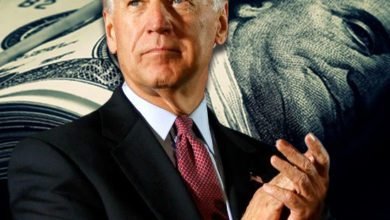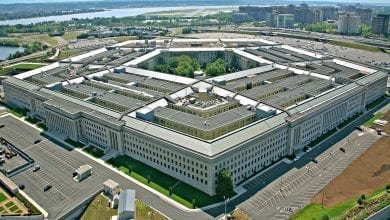Medal of Honor Monday: Army Lt. Col. Don C. Faith Jr.
Army Lt. Col. Don Carlos Faith Jr. was one of thousands of men forced to fight through frigid conditions and overwhelming odds during the Korean War’s Battle of Chosin Reservoir. He didn’t survive the ordeal, but the leadership and bravery he showed while commanding troops earned him a posthumous Medal of Honor.
Faith was born Aug. 26, 1918, in Washington, Indiana, to parents Katherine and Don Faith Sr., who was a World War I Army general. As an Army brat, the younger Don and his two brothers, Francis and Edwin, grew up all over the world, including in China, the Philippines, Georgia and Washington, D.C.
In the late 1930s, Faith attended Georgetown University, where his father was then the director of veterans’ education, according to a 1950 edition of the Washington, D.C, newspaper, The Evening Star. But by June 1941, he decided he wanted to follow in his father’s footsteps by joining the Army, months before Pearl Harbor would thrust the U.S. into World War II.
After basic training, Faith went to Officer Candidate School and received his commission before being assigned to the 82nd Airborne Division. Faith was first stationed at Camp Claiborne in central Louisiana, where he met Barbara Wilbur. They married in November 1942 and eventually had a daughter, Bobbie.
Faith went on to serve in North Africa, Italy, France and Germany, earning two Bronze Stars and the French Croix de Guerre for his actions. When the war was over, he was stationed for a short time in the Philippines before being sent home to serve as the Army secretary to the United Nations Military Staff Committee.
In early 1948, Faith served in China before joining occupation forces in Japan, where he was stationed when the Korean War began in June 1950. By then, he was a lieutenant colonel and was given command of the 1st Battalion, 32nd Infantry Regiment. A short time later, they were sent to Korea.
By November 1950, United Nations troops, which were largely American, had pushed the North Koreans north toward the border with China. Around the same time, China decided to join the war on the enemy’s side, so it sent thousands of its own troops south across the Yalu River to help the fleeing North Koreans.
The Battle of Chosin Reservoir, as the ensuing fight is now called, was one of the most savage battles of the war, playing out in rugged, hotly contested terrain during one of the coldest winters on record for the region. Temperatures, which reached about -40 degrees Fahrenheit, were so cold that weapons malfunctioned, and foxholes couldn’t be dug because the ground was too hard, historians said.
Starting on Nov. 27, 1950, about 100,000 Chinese soldiers encircled the Chosin Reservoir near the village of Sasu-ri, quickly outnumbering and outgunning about 30,000 UN troops, including Faith’s 1st Battalion. When enemy troops launched a fierce attack against them, Faith directed the action amid heavy fire and even led counterattacks to restore positions that had been breached.
At one point, Faith directed an attack that would help his battalion link up with another unit, the 31st Regimental Combat Team, which was in dire need of help. Faith did reconnaissance on the route they would take and personally directed the first elements of his command across the ice-covered reservoir. He then directed the battalion’s vehicles, which were loaded with wounded men, until all his command had passed through enemy fire. Only then did he allow himself to cross the reservoir.
When the battalion reached the beleaguered 31st RCT, Faith assumed their command. Nicknamed Task Force Faith, the combined unit was ordered to organize its survivors and withdraw south about 14 miles to Hagaru-ri, where they would be able to join with more friendly forces.
Although they were all exhausted by the bitter cold and physical effort, Faith rallied his men and launched an attack. When they were quickly stopped by enemy fire, Faith ran forward and got his stalled men moving so they could blast their way through the enemy ring.
By Dec. 1, days had passed since the troops had begun their flight south, and they were still being attacked.
According to Faith’s Medal of Honor citation, “As they came to a hairpin curve, enemy fire from a roadblock again pinned the column down. Faith organized a group of men and directed their attack on the enemy positions on the right flank. He then placed himself at the head of another group of men and, in the face of direct enemy fire, led an attack on the enemy roadblock, firing his pistol and throwing grenades.”
Faith managed to get within about 30 yards of the roadblock when he was seriously wounded by grenade fragments; however, he continued to direct the attack until the roadblock was overrun. Unfortunately, Faith didn’t survive his injuries and died the next day, according to the Defense POW/MIA Accounting Agency.
By the end of the Battle of Chosin Reservoir on Dec. 13, UN troops managed to break through the enemy siege and move south far enough to evacuate more than 100,000 North Korean refugees.
Throughout five days of action during that movement, Faith continuously disregarded his own safety, often throwing himself into the most dangerous situations to keep others safe. His actions were a great inspiration to his men, which led to him posthumously earning the Medal of Honor. His wife and daughter received it on his behalf from famed World War II Army Gen. Omar Bradley.
“Mrs. Faith, I have known Don since he was a little boy, and I’m not surprised at his leadership and courage,” Bradley told Faith’s wife during a ceremony at the Pentagon, according to The Evening Star. The newspaper said nine other Korean War service members received the Medal of Honor during the same ceremony.
A Delayed Homecoming
Sadly, Faith’s remains couldn’t be repatriated because of battlefield conditions at the time, so the family had nothing to bury. Instead, his name was inscribed on the Courts of the Missing at the National Memorial Cemetery of the Pacific in Honolulu.
In 2004, joint investigators were allowed into North Korea to survey a field near the Chosin Reservoir, where they located a mass grave site, the DPAA said. Boxes of remains were exhumed and returned to the U.S. for identification. However, that process can take years due to the challenges that come with identifying remains that are lumped together.
In August 2012 — nearly 62 years after Faith died — the DPAA positively identified his remains as part of the batch that had been repatriated in 2004. Less than a year later, on April 17, 2013, Faith was finally laid to rest at Arlington National Cemetery.
To date, there are still 7,485 Americans who are unaccounted for from the Korean War, according to DPAA’s website.
Faith’s name continues to live on. In the 1990’s, a headquarters building was built in his honor at Fort Drum, New York. His name is also inscribed on the Korean War Veterans Memorial Wall in Washington, D.C., which was updated in 2022 to include the names of the fallen.
This article is part of a weekly series called “Medal of Honor Monday,” in which we highlight one of the more than 3,500 Medal of Honor recipients who have earned the U.S. military’s highest medal for valor.
Source: Department of Defense
Content created by Conservative Daily News is available for re-publication without charge under the Creative Commons license. Visit our syndication page for details.




